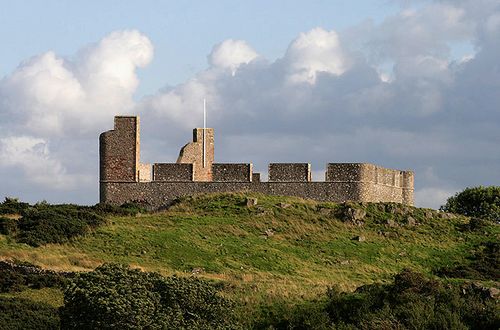Annotation:Hume Castle (2): Difference between revisions
m (Text replacement - "garamond, serif" to "sans-serif") |
No edit summary |
||
| Line 1: | Line 1: | ||
__NOABC__ | |||
<div class="noprint"> | |||
<p><font face="Century Gothic" size="4"> Back to [[{{BASEPAGENAME}}]] </font></p> | |||
</div> | |||
---- | ---- | ||
<p><font face=" | {{#lst:{{PAGENAME}}|abc}} | ||
---- | |||
<div style="page-break-before:always"></div> | |||
<p><font face="Century Gothic" size="3"> | |||
<div style="text-align: justify; direction: ltr; margin-bottom: 90px; margin-left: 70px; margin-right: 120px;"> | |||
<br> | <br> | ||
'''HUME CASTLE [1]'''. Scottish, Reel (whole time). G Major. Standard tuning (fiddle). John Glen (1891) finds the earliest printing in [[biography:Daniel Dow]]'s (1732-83) '''A Collection of Ancient Scots Music for the Violin, Harpsichord, or German Flute never before printed''' (1775, Edinburgh, p. 20). A tune called "Hume Castle" also appears in the Thomas Calvert Collection of 1799. Calvert was a musician from Kelso, Scotland (near Hume), and a note with the collection states that Calvert supplied "a variety of music and instruments, instruments lent out, tun'd and repaired." Hume Castle was once the seat of the Hume/Home family, and the original structure dates from the 13th century. The medieval building was destroyed by Cromwell's artillery in 1651. In 1794 the Earl of Marchmont built a new castle on the same foundations, however, it appears that it was never completed (or only meant for show) and remained only a shell that may be seen today from Marchmont and other points in the border region between Scotland and England. The castle site commands exquisite views and was used as a lookout and beacon station from the Napoleonic Wars through World War II. | |||
[[File:hume.jpg|500px|thumb|left|Viewed in evening light from Hume Craigs.© Copyright Walter Baxter and licensed for reuse under this Creative Commons Licence]] | |||
<br> | <br> | ||
<br> | |||
</div> | |||
</font></p> | </font></p> | ||
<p><font face=" | <div class="noprint"> | ||
''Source for notated version'': | <p><font face="Century Gothic" size="3"> '''Additional notes''' </font></p> | ||
<p><font face="Century Gothic" size="3"> | |||
<font color=red>''Source for notated version''</font>: - | |||
<br> | <br> | ||
<br> | <br> | ||
</font></p> | </font></p> | ||
<p><font face=" | <p><font face="Century Gothic" size="3"> | ||
''Printed sources'': | <font color=red>''Printed sources''</font> : - | ||
<br> | <br> | ||
<br> | <br> | ||
</font></p> | </font></p> | ||
<p><font face=" | <p><font face="Century Gothic" size="3"> | ||
''Recorded sources'': <font color=teal></font> | <font color=red>''Recorded sources'': </font> <font color=teal> - </font> | ||
</font></p> | </font></p> | ||
<br> | <br> | ||
---- | ---- | ||
<p><font face="Century Gothic" size="4"> Back to [[{{BASEPAGENAME}}]] </font></p> | |||
</div> | |||
__NOEDITSECTION__ | |||
__NOTITLE__ | |||
Revision as of 04:34, 17 August 2019
X: 1 T:Hume Caftle [2] M:4/4 L:1/8 Q:90 R:Reel B:Thomas Calvert Collection - Page 9 Z:Transcribed by Philip Whittaker H:Hume Castle - 6 miles North of Kelso was rebuilt as a folly by the H:Earl of Marchmont in 1794 - five years before the publication of this H:collection K:G c|BG (3Bcd ~B2 Bd | egdg BAAc | BGGc Bddg | e/2d/2c/2B/2 Ad BGG :|| c|Bddg egdg | BddB cAAc | Bddg egdg | Bgdg BGGc | Bddg egdg | BddB cAAc | Bdgb afdg | e/2d/2c/2B/2 Ad BGG ||
HUME CASTLE [1]. Scottish, Reel (whole time). G Major. Standard tuning (fiddle). John Glen (1891) finds the earliest printing in biography:Daniel Dow's (1732-83) A Collection of Ancient Scots Music for the Violin, Harpsichord, or German Flute never before printed (1775, Edinburgh, p. 20). A tune called "Hume Castle" also appears in the Thomas Calvert Collection of 1799. Calvert was a musician from Kelso, Scotland (near Hume), and a note with the collection states that Calvert supplied "a variety of music and instruments, instruments lent out, tun'd and repaired." Hume Castle was once the seat of the Hume/Home family, and the original structure dates from the 13th century. The medieval building was destroyed by Cromwell's artillery in 1651. In 1794 the Earl of Marchmont built a new castle on the same foundations, however, it appears that it was never completed (or only meant for show) and remained only a shell that may be seen today from Marchmont and other points in the border region between Scotland and England. The castle site commands exquisite views and was used as a lookout and beacon station from the Napoleonic Wars through World War II.

